► Merc vs Lambo vs Range Rover
► G63 vs Urus vs 5.0 V8
► Welcome to 2019
What a strange place we find ourselves in – a place where the Range Rover is the subtle, safe, good-value option. It’s been with us for 39 years and throughout the decades it has – alongside considerable acclaim – been criticised as too big, too vulgar, too thirsty and too expensive
Not any more.
In today’s Giant Test the Range Rover sits proudly in the middle of the road – a road that’s part greenlane and part racetrack, spanning school run and desert adventure, and which takes in Dubai, Beverly Hills, Moscow, Mayfair and the Scottish Highlands. Prices start around £80,000, but our V8 Supercharged Autobiography is £30k extra.
Best electric SUVs
The contenders
At one extreme sits the Lamborghini Urus: Batmobile styling, near-supercar performance and a starting price of £165,000. And at the other extreme is the G63 AMG version of the Mercedes G-Class, a model line which has been around for 40 years, although received its most significant ever update in 2018. This latest generation looks ready to stop being a cult classic and start being a serious option. The car’s changed but nothing like as much as the market has changed. When the G-Class was born, it was of interest chiefly to lumberjacks, armies and aid agencies. Now, it’s significant that half of all G-Class sales are for the AMG version. Britain gets just two models: the entry-level G350d at £92,000 and the 63 at more than £143,000.
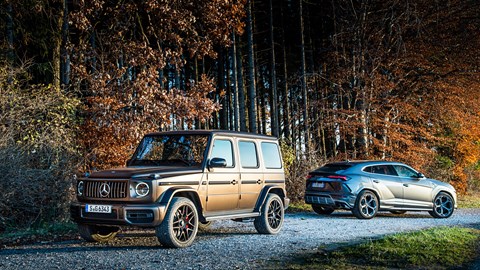
Today’s trio are not outliers. The test could also have included the Rolls-Royce Cullinan and Bentley Bentayga, or the relatively sane Audi Q8 and Porsche Cayenne. On the horizon we have the Ferrari Purosangue and Aston Martin DBX. These big, powerful SUVs are big business.
The Urus, Range Rover and G63 are united by a mix of on-road performance, off-road ability, ruggedness, luxury and premium fixtures and fittings; they’re all clearly, deliberately SUVs. But within that broad similarity, each has its own set of ambitions. The Urus wants to be the fast one. The Range Rover is a luxury car that’s ready for anything. The G-Class is an off-roader that can go fast on road. If the Urus is a supercar in hiking boots, and the Range Rover is a Hermes Swiss army knife, the G63 is a mountaineer swigging Red Bull. We’re judging them not just against each other but also against their stated aims.
The Lambo
The Lamborghini leaves no doubt about its priorities: supercar soul, SUV packaging. It targets performance in all conditions, and claims the best power-to-weight ratio of any SUV. The body is streamlined and muscular, with sports-car proportions, a bulging bonnet and a generous serving of Lamborghini’s favoured hexagons and Y shapes. It’s the lowest car here.
The 641bhp twin-turbo 4.0-litre V8 fitted to the Urus is the highest-performance edition of a VW Group engine developed by Porsche. Whereas the Range Rover is available with a diesel V6 and V8, and a hybrid that uses a 2.0-litre petrol four, as well as our supercharged petrol V8, and the G-Class range includes a diesel, the insanely irrational Urus is petrol only, and lots of it, which tells you plenty about how Lamborghini sees the Urus. It has four-wheel steering, all-wheel drive with active rear torque vectoring, adaptive air suspension with active dampers, active anti-roll bars and carbon-ceramic brakes. It has three on-road and three off-road modes.
The Range
Our Range Rover is the odd one out by being supercharged rather than turbocharged. Its 5.0-litre V8 makes 518bhp. Suspension is fully independent, with double wishbones up front and a multi-link rear. Damping is continuously variable.
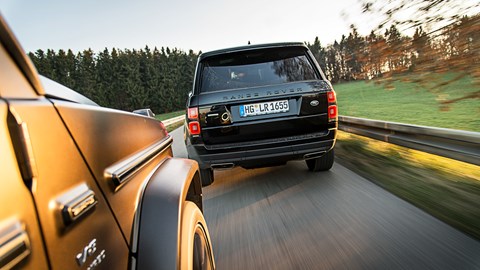
As well as an active locking rear differential there are three on-road driving modes and three off-road, plus Low Traction Launch System and Hill Descent Control. The car’s overall height can be raised for extreme off-roading and lowered for easy access; it automatically lowers above 65mph to reduce drag.
The G-Wagon
More so than the Range Rover, the G-Class has a predominantly off-road heritage, but there have always been hot, more road-biased variants. The G63 uses a version of AMG’s 4.0-litre V8 with two twin-scroll turbochargers, here in 577bhp form. The 63 comes with a lot of AMG detailing – a different grille, illuminated lettering on the door sills, 20in wheels, red brake calipers – and a very high spec level inside.
Although the design is broadly true to G-Class tradition, the 63’s cabin would not confuse or disappoint an E-Class or S-Class driver.
It’s underpinned by a ladder-frame chassis with coil springs all round. There’s an independent double-wishbone set-up at the front and a rigid axle at the rear with five-link suspension. Adaptive adjustable damping is standard, as is speed-sensitive electro-mechanical steering – its first outing on a G-Class.
There are three lockable differentials in the rear-biased all-wheel-drive system. The transmission is Merc’s familiar nine-speed automatic, with bespoke software. You can override the auto shifts by using the paddles, and pressing the Manual switch will stop it making unwanted upchanges. There are five on-road driving modes, and three off-road.

The 63’s wheelarches are more flared than those on other Gs; wheels of 21 and 22 inches can be specified.
Options include the AMG Driver’s package, which is a £2000 software update that takes the top speed up from 137 to 149mph. But the dirt fraternity will be happy too, as it comes with an old-school low-range setting for the transmission; off-road driving is something to be enjoyed, not endured.
The Urus looks short and low and compact in this company, but it is actually 112mm longer than the Range Rover (not the long-wheelbase version) while eclipsing the Mercedes by 239mm. In combination with the longest wheelbase, you would expect a tangible packaging advantage. However, it has less luggage space than the much shorter Merc (616 litres for the Urus versus 667 in the G) and it’s walloped by the Range Rover’s 900 litres.
The Super SUV experience
Three big SUVs, three different ways of accessing the load bay. The Merc’s is side-hinged and ultra-heavy because of the spare wheel attached to it. The Range Rover’s is horizontally split – good for picnics, not great for heaving heavy suitcases in. The Lamborghini’s is top-hinged, estate-style, and is home to two spoilers that restrict your rear view.
The Lambo’s aircraft-inspired cabin has three screens: one for the instruments, one for infotainment, one for comfort functions. The interior can come with a three-person rear bench or two individual rear seats (which trims boot space by 41 litres). Boasting classy seats and expensive materials, the cabin attempts to fuse the practicality of a daily driver with the flair of a proper sports car, with some success.
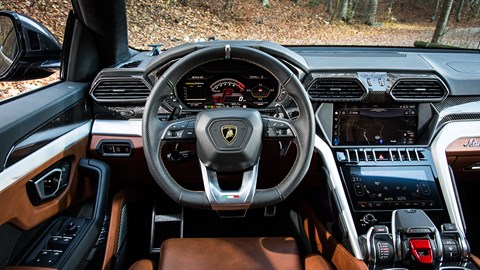
The Range Rover has a supremely high level of traditional cabin luxury, front and rear, with a good amount of adjustment – some of it controllable via smartphone. Heated armrests are among the many neat, user-friendly details.
In the G-Wagen, you feel invincible. The commanding driving position has great visibility, expensive surfaces, much improved seats but not yet the latest MBUX infotainment software. The steering-wheel controls are numerous and messy, the list of driver-assistance systems is short for a new model, the inner door handles could not be more awkward to operate, and the doors themselves feel slightly too close to the occupants.
Welcome remnants from the past are the in-dash push buttons that lock the three diffs (the one in the middle is now of the variable-rate, multi-plate clutch kind), the essential hewn-from-solid passenger grab-handle and the world’s noisiest central-locking system. The rear seats aren’t huge but they are comfortable, and can be folded individually.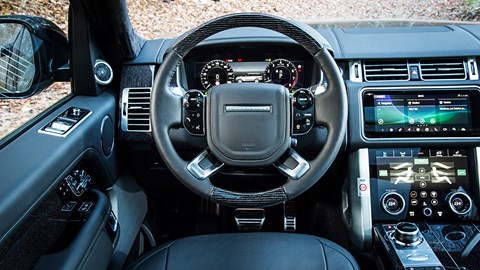
Today’s test cars are all genuinely capable on a variety of terrains; a significant number of customers live near deserts or own large tracts of countryside, after all. With the air suspension set in the tallest position, the dampers in soft and ESP in Corsa, the Lamborghini is the uncrowned king of the gravel road, even though putting it through its paces may require a respray every 1000 miles or so.
The Range Rover, when confronted with hillclimbs and river crossings, lives up to its reputation. It does a great job of cushioning, isolating and distancing you from the terrain it wafts over. It’s not one single talent that does the trick but a blend of virtues and abilities. The dynamic soul lies in the flow, and that flow is now more concise and linear than ever. Although you can dial in specific set-ups, Auto selects a fine balance. A spirited and inspiring drive, the Range Rover never feels stretched.
Lacking a height-adjustable chassis, the only terrain the G63 dislikes is deep sand. Sporting enormous spring travel and wheel articulation, a trick all-wheel-drive system complete with low-range transfer case and enough ground clearance to straddle junior boars, the Merc rules rocky terrain.

On the road, the Lamborghini lives up to its claims. We’re not only talking acceleration and top speed here, but also handling, steering, brakes and feel. With Corsa mode engaged and the mind set in fast forward, the stealth-grey Lambo never ceases to surprise its driver and shock other road users. You can brake absurdly late and hard, confident that the tyres won’t let go. And even during braking, early turn-in doesn’t feel risky. Yes, there is some understeer, but nothing a momentary flick at the wheel or a faint lift-off won’t fix.
The Urus practically owns the road between 125mph and 190mph. The sixth sense built into the throttle pedal, the instant-response turbochargers and the telepathic eight-speed transmission let the 627lb ft light up the driveshafts like a miniature nuclear implosion. True, the short-lived Audi SQ7 was torquier still, but in terms of aggregate impact and effect, even the awesome 700bhp Jeep Grand Cherokee Trackhawk must settle for second place. The Urus is, on the road, the quickest stock SUV money can buy. And with a top speed of 191mph, the Urus is merely 10mph slower than the base Huracan which beats its five-door sister model narrowly by 3.4 against 3.6sec in the 0-62mph run.
The Range Rover feels very different. Quieter. Softer. Plusher. Still plenty of grunt to play with, though. But next to the Urus it can feel unexciting. Its character is devoid of extremes and excesses. It simply does its job, and it does it well. It is ergonomically on par with the competition, and is fitted with a comparable quantity of assistance systems.
The supercharged engine never was an object lesson in efficiency and refinement, but the progressive torque delivery underlines the S in SUV. Travelling to the redline is calmer than in either of the others, and is involving and quietly rewarding rather than thrilling. The Urus and G63 can reel in the horizon even faster, but they both feel busier and more agitated. The Range Rover driver lets them pull away, not because it’s slower but because the British car encourages a smoother approach. The Range Rover needs 5.4sec for the 0-62mph stunt, and it will do 155mph if so required. But it’s more about high average speeds, thanks to its all-day comfort and refinement.
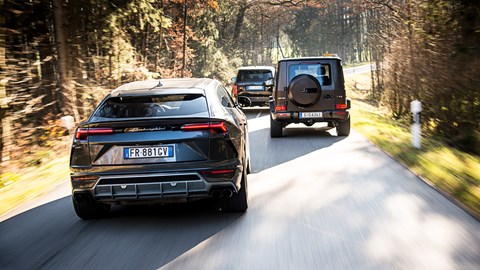
On paper, the Range Rover is thirstiest at 20.0mpg, closely followed by the Mercedes (21.4mpg) and the Lamborghini (22.2mpg). On an empty German autobahn, though, the G63 was the least economical, dropping to 7mpg at one point.
The AMG is, in its way, as flamboyant as the Lamborghini. It puts on a show, growling and squealing through the gears. Directional stability that depends on the quality of the road contributes to its relatively edgy feel. Its high centre of gravity poses a challenge the adaptive dampers sometimes struggle with.
Genetically it’s part-HGV and yet it can be faster off the mark than an S600 V12. Up to 110mph, the relentless forward thrust never ceases to amaze. Even at this speed, kickdown makes the nine-speed automatic shift down two or three gears so you can thunder on without losing momentum. Like every AMG, the G spits and spats at idle, rumbles and roars up and down torque mountain, blares and trumpets on the approach to the 7000rpm redline. At 78dBa, it’s 8dBa louder than the Range Rover at 100mph. That’s loud, even compared with the Lamborghini.
Super SUVs: verdict
The three super SUVs are leagues apart in the way they perform. If you must have an SUV with the soul of a sports car, take the Lamborghini. If you’re into a retro-look head-turner crammed with contemporary engineering, you may be a G-Class type. The Range Rover is the luxury GT of the SUV guild. Less ostentatious than Bentayga or Cullinan, it’s an old-school grand cruiser full of class. It invented the segment, and it still owns a good part of it. The Range Rover can do town and country, highway and byway, short hops and long hauls. If you want the best all-rounder at the best price, the oldie but goodie from Solihull is the upper-crust SUV to go for.
But it has been around for a while, and this shows at times. Its braking and steering could be better, and at times it’s overshadowed by the way the Lamborghini and Mercedes combine competence, idiosyncrasy and excitement.
Mercedes-AMG G63
- Price £143,305
- Engine 3982cc 32v twin-turbo V8
- Transmission 9-speed auto, all-wheel drive
- Performance 0-60mph 4.5 secs, 577bhp @ 6000rpm, 627 lb ft @ 2500-3500rpm, top speed 137mph
- Suspension Double-wishbone front; five-link rigid rear axle with Panhard rod
- Made of Steel, aluminium 2560kg
- Dimensons 1969mm x 1984mm x 4873mm
Lamborghini Urus
- Price £164,950
- Engine 3996cc 32v twin-turbo V8
- Performance 0-60mph 3.6 secs, 614bhp @ 6000rpm, 627lb ft @ 2250rpm, top speed 191mph
- Transmission 8-speed auto, all-wheel drive
- Suspension Multi-link front and rear, air springs
- Made of Aluminium, composite 2197kg
- Dimensions 1638mm x 2016mm x 5512mm
Range Rover 5.0 V8 Autobiography
- Price £110,235
- Engine 5000cc 32v supercharged V8
- Transmission 8-speed auto, all-wheel drive
- Performance 0-60mph 5.4 secs, 518bhp @ 6000rpm, 461lb ft @ 2500rpm, top speed 155mph
- Suspension Double-wishbone front, multi-link rear, air springs
- Made of Aluminium, 2450kg
- Dimensions 1869mm x 2073mm x 5112mm